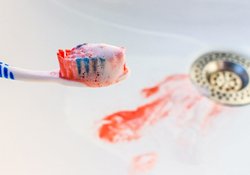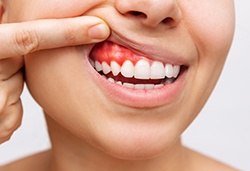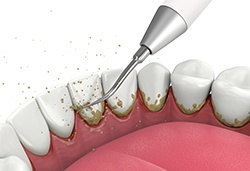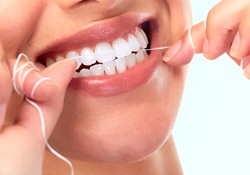GUM DISEASE TREATMENT – HARRISONBURG, VA
Protect Your Gums. Protect Your Health
Periodontal disease (also known as gum disease) is actually the most common dental problem in the entire world. Early symptoms include red, swollen, and tender gum tissue that also tends to bleed after brushing and flossing. If these symptoms are left untreated, this infection can eventually lead to tooth loss! At Harrisonburg Family & Cosmetic Dentistry, we take the health of our patients' gums very seriously. If our team finds any signs of this disease, we can quickly treat it using a range of treatments known as periodontal therapy.
What is Gum Disease?
There are multiple stages of gum disease ranging from mild to severe. As harmful bacteria builds on the teeth and around the gum line, it can cause inflammation, bleeding, and tenderness to occur within your gums.
What can start as gingivitis, which can be easily reversed with a thorough dental cleaning and consistent oral hygiene habits practiced at home, can quickly escalate to periodontitis. This is when the gums begin to pull away from the teeth and infection can occur. If left untreated, plaque will spread further down into the gums and lead to bone and tooth loss, as well as potential health-related problems and conditions, such as heart disease and neurological disorders.
Signs of Gum Disease
Some of the most common signs associated with gum disease include:
- Red, puffy, tender gums
- Inflamed or bleeding gums
- Bad breath
- Gums that are receding
- Deep pocket formations between your teeth and gums
- Shifting or loose teeth
- Changes in your bite
Treatment Options for Gum Disease
 Although symptoms can be
subtle, it is best if you begin to notice any changes that you call our office immediately. One of our qualified
dentists will be able to examine your teeth and gums to determine if periodontal therapy is necessary.
Fortunately, while some cases of gum disease are irreversible, we can prevent the problem from worsening and
give your gums a better chance at improved health. Some of the treatment methods used to help our patients
include:
Although symptoms can be
subtle, it is best if you begin to notice any changes that you call our office immediately. One of our qualified
dentists will be able to examine your teeth and gums to determine if periodontal therapy is necessary.
Fortunately, while some cases of gum disease are irreversible, we can prevent the problem from worsening and
give your gums a better chance at improved health. Some of the treatment methods used to help our patients
include:
Scaling & Root Planing

If you are showing signs of gum disease, we may try to treat it using something called a “deep cleaning,” which actually consists of two separate but complementary procedures known as scaling and root planing (SRP). The goal of SRP is to rid the mouth of harmful bacteria so the gums have an opportunity to heal.
Do I Need Scaling & Root Planing?

You may benefit from scaling and root planing if you are manifesting common signs of gum disease, such as:
- Bleeding easily when you brush and floss your teeth.
- Red, swollen gums.
- Gum recession.
- Persistent bad breath.
- Visible plaque buildup along your gumline.
If your gum disease is still very mild, it might be reversible via at-home oral hygiene. Otherwise, we might recommend that you undergo SRP. After an initial evaluation, our team will be able to customize a treatment plan to meet your unique needs.
The Process of Scaling & Root Planing

With scaling, our team will use small tools to gently break up and clear away plaque and tartar deposits located near and underneath your gumline. Then, root planing will be used to gently smooth out the rough surfaces of your teeth’s roots. This will make it much harder for plaque to accumulate on them in the future, which means you'll be less likely to develop gum disease again. Depending on the extent of your infection, an entire deep cleaning can typically be completed in about one to four appointments. Before beginning, we will thoroughly numb the area with local anesthesia to make sure you are comfortable throughout your treatment.
Aftercare Tips for Scaling & Root Planing

SRP is an intensive treatment, so your gums and teeth may be tender and sore for a few weeks afterward. To reduce your discomfort, you should:
- Be gentle but thorough when brushing and flossing. Be sure to use a soft brush and move it in a circular pattern.
- Regularly rinse your mouth with warm salt water. This can help to calm inflammation and reduce irritation.
- Mind your diet. You may need to avoid spicy, hot, crunchy, and hard foods for a while.
- Get plenty of rest. Being too physically active in the first few days after your procedure might slow down your body’s ability to heal.
ARESTIN® Antibiotic Treatment
After your deep cleaning, our dentists may choose to apply a topical antibiotic to your gums in order to further fight the infection. Bacteria associated with gum disease will typically gather and multiply in the small spaces between your gums and teeth, which are known as periodontal pockets. While scaling and root planing can eliminate much of this bacteria, the treatment may not be able to reach all of it if the periodontal pocket is deep enough. That’s where antibiotic treatment comes in.
Your dentist or hygienist will apply the wax-like substance directly to your infected gums, which is made of thousands of tiny micro-spheres. Each of these micro-spheres is filled with a powerful anti-microbial agent. This will slowly dissolve over the next seven days so that it can reach the deepest bacterial accumulations. Between this, your deep cleaning, and diligent brushing and flossing at home, our patients should see complete relief from your gum disease.
How to Maintain Gum Health

To prevent your gums from ever experiencing any of the above-mentioned symptoms, it is advised that you follow these tips to maintain proper gum health:
- Use a soft-bristled toothbrush to brush your teeth twice a day for two full minutes. You’ll want to turn the brush to a 45-degree angle and use a circular motion to clean the entire surface of your tooth and gum line.
- Talk to your dentist about the right type of toothpaste to combat gum disease and use it daily.
- Floss gently between your teeth after every meal.
- Rinse with an antimicrobial mouthwash.
- Avoid sugary or starchy foods, as they can cause harmful bacteria to feed and burrow into the crevices of your teeth, resulting in tooth decay and gum disease.
- Maintain your regularly scheduled appointments with your dentist. The typical timeline is every six months; however, for periodontal patients, it is necessary to meet with us more frequently.
Periodontal Disease FAQs

Although half of Americans have gum disease, it’s normal to have several questions about the infection and the road ahead. You’re going to need periodontal therapy to restore your gum health. We’ll explain everything during your consultation to ease any apprehensions. While you wait for your visit, here are the answers to a few frequently asked questions.
What does gum disease look like?
The early signs of gum disease, called gingivitis, are often attributed to brushing or flossing too aggressively. However, red, swollen, and bleeding are red flags. Although the early symptoms might not appear concerning, the infection will continue to wreak havoc on your smile. Over time, you can develop chronic bad breath, gum recession, pus pockets near the roots, and tooth sensitivity. In advanced cases, your teeth can shift from position, loosen, or fall out.
Can gum disease be cured?
With early intervention, gingivitis can be reversed without causing any long-term damage to your smile. Often, a deep cleaning is all that’s needed to resolve the issue. If you don’t get the care you need, the infection will spread into your surrounding tissues, which can cause irreversible complications, like tooth loss. If the infection reaches advanced stages, you’ll require a more aggressive treatment plan to reinstate your gum health and repair any damage.
Are periodontal issues genetic?
Gum disease is caused by bacteria found in plaque and tartar buildup. Although it’s often the result of poor oral hygiene habits, other factors can contribute to the infection, like your genetics. Some people have a higher risk for gum disease because of their family history. Your dentist can create a personalized plan to help safeguard your gum health. While you can’t change your DNA, you can take several steps to lower your risk of the infection, like brushing, flossing, and visiting your dentist twice a year for a cleaning and checkup.
Does gum disease hurt?
You may notice your gums are a little tender when brushing and flossing your teeth, but your discomfort can increase as the infection progresses. Besides sore gum tissue, you might also develop tooth sensitivity or pain when biting and chewing. Your dentist can stop your discomfort with periodontal therapy.
Are "deep cleanings" covered by insurance?
Although every policy differs, dental insurances almost always cover periodontal therapy. Most insurance companies cover 2 deep cleanings per year. After a copayment, you’ll enjoy 100% coverage. We know dental insurance can be confusing, but you don’t have to navigate your policy alone. A member of our team will work on your behalf with your insurance company to maximize your annual benefits. Besides deep cleanings, you can also use your policy to offset the cost of restorative procedures necessary to repair any damage caused by the infection. After reaching your annual deductible, your coverage can pay up to 80% of the cost until hitting your yearly limit. If there’s any out-of-pocket expense, we’ll explain your payment options to find the solutions you need to keep a healthy smile within your budget.

